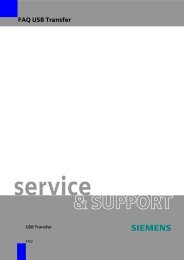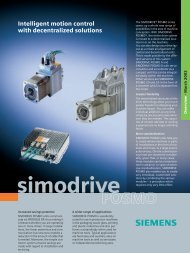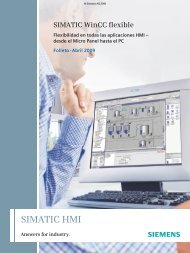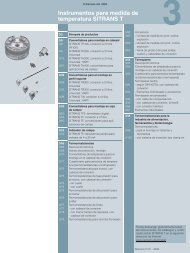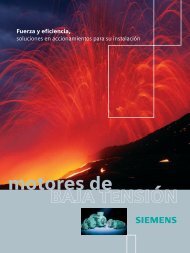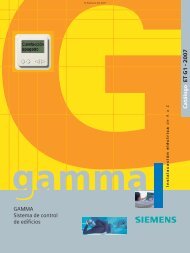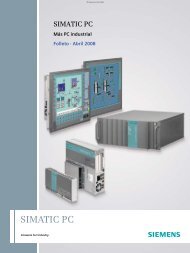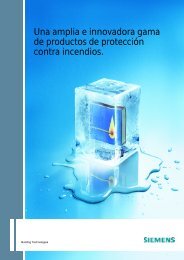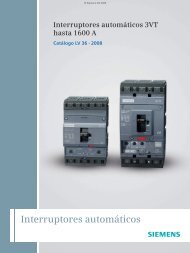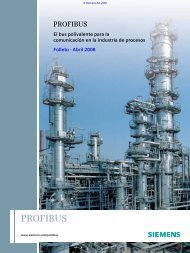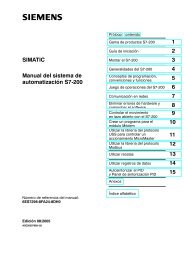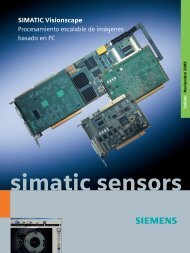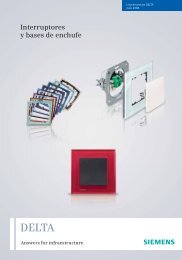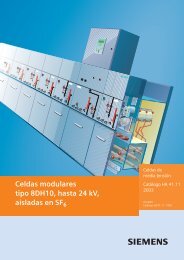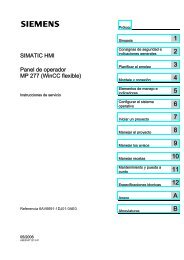Create successful ePaper yourself
Turn your PDF publications into a flip-book with our unique Google optimized e-Paper software.
© Siemens AG 2007<br />
<strong>BD01</strong> <strong>System</strong> — <strong>40</strong> ... <strong>160</strong> A<br />
Engineering information<br />
■ Function<br />
Required details<br />
The following data must be considered when configuring the<br />
busbar runs:<br />
• Installation flat or edgewise, horizontal or vertical, quantity,<br />
type and approximate ratings of prospective loads, p.f.<br />
• Utilization and rated diversity factor = derating factor α.<br />
• If data are not available, use only the rated diversity factor<br />
• Feeding transformers (short-circuit current)<br />
• Nature of the installation site (dimensions, construction of the<br />
building, transport paths, cellar)<br />
• Routing of supply lines from other power sources<br />
• Crane operation<br />
• Special requirements<br />
Operational current<br />
The operational current is calculated using the following formula:<br />
I B =<br />
P inst × α × b<br />
!3 ×U ×cosϕ<br />
with:<br />
I B = Operational current (A)<br />
P inst = Installed power (kW)<br />
α = Derating factor<br />
b = Supply factor<br />
b = 1 = Single end feed<br />
b = ½ = Double end feed<br />
U e = Rated operational voltage (V)<br />
cos ϕ = Power factor<br />
Short-circuit protection<br />
A system can be protected against short circuit alone, by fitting<br />
low-voltage LV HRC fuse links (gL) into the incoming supply; the<br />
fuse size to be appropriate for the prospective short-circuit<br />
current at the point of installation.<br />
Overcurrent protection equipment for overload and<br />
short-circuit protection<br />
Busbar trunking systems must be protected against overload<br />
and short circuits. Fuses and miniature circuit-breakers must be<br />
selected so that the admissible current carrying capacity corresponding<br />
with the ambient conditions is not exceeded.<br />
Due to their high response threshold (1.3 to 1.6 times rated current)<br />
and their long rupturing times at small overcurrents, fuses<br />
are not suitable for overload protection. Therefore we recommend<br />
the use of motor-protective or standard circuit-breakers.<br />
The following can be used:<br />
<strong>System</strong> Overcurrent protective devices<br />
× 10 3 I cc = 15 kA 1)<br />
I cc = 25 kA<br />
<strong>BD01</strong>-<strong>40</strong> 5SY4 3<strong>40</strong>-6 3VL27 05<br />
<strong>BD01</strong>-63 5SY4 363-6 3VL27 06<br />
<strong>BD01</strong>-100 – 3VL27 10<br />
<strong>BD01</strong>-125 – 3VL27 12<br />
<strong>BD01</strong>-<strong>160</strong> – 3VL27 16<br />
1) I cf = Rated short-circuit current of the busbar trunking system and its outgoing<br />
circuits when protected by circuit-breakers<br />
The prospective network short-circuit current and the let-through<br />
characteristic of the switches must be taken into account in each<br />
case.<br />
Temperature characteristic of <strong>BD01</strong> systems<br />
If no data are available about the actual currents occurring simultaneously,<br />
the following values according to IEC/EN 60439-1<br />
apply:<br />
Number of main circuits<br />
2 and 3<br />
4 and 5<br />
6 to 9 inclusive<br />
10 or more<br />
Rated diversity factor α<br />
0.9<br />
0.8<br />
0.7<br />
0.6<br />
Rated current (%)<br />
130<br />
120<br />
110<br />
100<br />
90<br />
80<br />
NSV0_00071<br />
4<br />
70<br />
-5<br />
+5 +15 +25 +35 +45 +55 +65<br />
Ambient temperature °C<br />
(average over 24 hours)<br />
Siemens LV 70 · 2006<br />
4/31



